| OFFER | |
| ISSUE PLAN | |
| CATALOGUE | |
| HISTORY OF STAMPS | |
| ONLINE WEB STORE | |
| STAMPS WITHDRAWN FROM POSTAL CIRCULATION | |
| PHILATELIC STORES | |
| WERSJA POLSKA |
25th Anniversary of the pacification of the "Wujek" coalmine
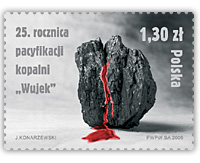
designer: Jacek Konarzewski
quantity of stamp 1
value: PLN 1.30
issue: 300.000 pcs
printing technique: offset
size of stamp: 43 x 31.25mm
paper: fluorescent
selling sheet: 20 stamps
circulation date: 16 December 2006
catalogue number: 4146
FDC
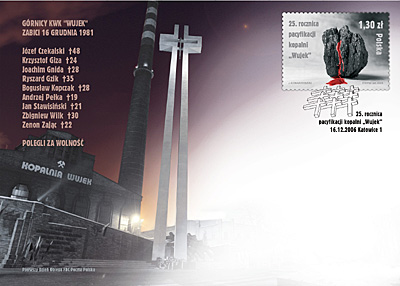
Dear collectors,
on the occasion of the 25th Anniversary of the pacification
of the "Wujek" coalmine Poczta Polska issued a post stamp commemorating
the tragedy of those days. A quarter of a century ago Poland was shaken by dramatic
events. On 13th December 1981 marshal law was introduced. The authorities arrested
opposition activists. The next day the miners of a few dozen of Silesia coalmines
went on strike to protest. Among others, they demanded the freeing of the detained
"Solidarity" leaders. On 16th December, on the area of the "Wujek"
coalmine, where almost 3 thousand were on strike, there took place fights with
the militia. The miners, attacked with water canons and tear gases, persistently
opposed, at which a special ZOMO squad used firearms. Nine miners were killed
by bullets and a few dozen wounded. Those responsible for the tragedy have not
been established until the present day. On the issued post stamp, created of
the initiative of the Silesia and Dabrowa "Solidarity" you can see
a bleeding lump of coal - symbolizing of the brutality and cruelty of those
events. The First Day of Circulation Envelope depicts the coalmine building
and a list with the names of miners killed on 16th December 1981. The FDC envelope
will be cancelled with a commemorative stamp used in Post Office Katowice 1.
Christmas

designer: Marzanna Dabrowska
quantity of stamp 2
value: PLN 1.30, PLN 2.40
issue: PLN 1.30 - 30.000.000 pcs
PLN 2.40 - 4.400.000 pcs
printing technique: rotogravure
size of stamp: 31.25 x 25.5 mm
paper: fluorescent
selling sheet: 100 stamps
circulation date: 30 November 2006
catalogue number: 4144 - 4145
FDC
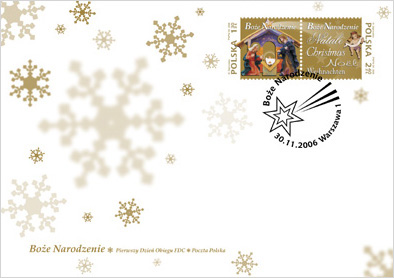
Dear collectors,
this year, to celebrate Christmas, Poczta Polska issued two stamps. One presents
the Christ-Child's crib, the second includes the word 'Christmas' written in
five languages, the same reminding that the holiday is celebrated not only in
Poland but worldwide and is for many for people in different parts of the world
exceptional. The author of the first Christ-Child's crib was supposedly St.
Francis of Assisi. In this way he wished to familiarize people with the history
of Jesus' birth. The Franciscans made common this beautiful element of Christmas
scenery. In the Christmas period the Christ-Child's crib is present in every
Polish church and frequent at peoples' homes.
Christmas is celebrated in many different ways by almost 1/3 of the world's
inhabitants, depending on the local tradition and the climate of the given part
of the world. In Poland it is associated with snow. However, e. g. in Australia
Christmas falls in the warm beach season. The Christmas period encompasses the
time span from the beginning of Advent to the Twelfth-Night, i. e. to 6 January.
In many countries the awaiting for Christmas is measured out by candles lit
every Sunday of the Advent or the popular among children advent calendars with
chocolates for every day of the month. All over the world children wait for
presents from Santa Claus, whose counterparts are, for example, in Poland Sw.
Mikolaj and Pai Natal in Portugal. Christmas meals must be substantial and varied.
In Italy mainly fish are eaten, and in English-speaking countries turkey. Christmas
tables also abound in flour and sweet dishes, frequently with honey, nuts and
almonds. Nonetheless, Christmas is everywhere associated with the atmosphere
of joy, peace and family warmth. A very nice and at the same time relatively
young (19th century) is the custom of sending cards with Christmas and New Year
greetings to relatives and friends.
The FDC envelope, accompanying the issue and decorated with golden snowflakes,
will be cancelled with a commemorative stamp used in Post Office Warsaw 1.
World Dog Show 2006 - Poznan

designer: Jacek Brodowski
quantity of stamp 5
value: PLN 1.30
issue: 5 x 500 000 pcs
printing technique: offset
size of stamp: 39.5 x 31.25 mm
paper: fluorescent
selling sheet: 20 stamps
circulation date: 6 November 2006
catalogue number: 4126-4130
FDC

Dear collectors,
this year in Poznan takes place the World Dog Show. For the first time it's
organized in Poland. In the period 9-12 November thousands of dogs with their
owners and breeders will arrive to the halls of the Poznan International Fair.
Poznan had already been the host of the European exhibition of 2000. It is also
here that the annual, most important dog exhibitions take place.
On the occasion of the enormous event, Poczta Polska presents a set of five
stamps with Polish pure breed dogs. The well known Tatra Mountain Sheep dog
is a shepherd dog of thick white coat met on mountain areas. It is friendly,
tame and disciplined. Therefore, it not only keeps watch over sheep herds but
e. g. also helps in rescue actions. The Polish Lowland Sheep dog is a nice,
medium sized dog whose characteristic feature is a long coat. It is also a shepherd
dog bred for many centuries. The next three breeds belong to hunting dogs. The
hounds (Polish Bloodhound and Polish Hound) were popular in noblemen's manors
from the 14th to the 18th century. The years of the partition of Poland and
years of wars made them almost extinct. It was only in the 50s that breeders
started to reproduce the hounds. The Polish Hound is a breed lately approved
by the International Kennel Federation (FCI) and more and more numerously represented
on exhibitions. The last breed presented on our stamps is the Polish Greyhound
- a large dog used since the 14th century in hunts for bustards, hares and wolves.
In the post-war years the prohibition of hound hunts led to the extinction of
the breed but since the 1970s it is being reconstructed. Polish dog breeds are
popular not only in Poland but also abroad, e. g. in Scandinavian countries
and in Germany.
Stamps are accompanied by an FDC envelope cancelled with a commemorative stamp
used in Post Office Poznan 1.
Capital Cities of EU States
 |
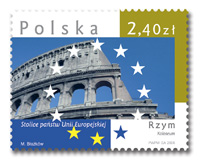 |
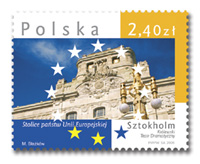 |
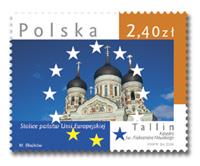 |
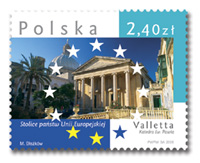 |
designer: Magdalena Blazkow
quantity of stamp: 5
value: PLN 2.40
issue: 4 x 500.000 pcs
1 x 200.000 pcs
(Rome)
printing technique: offset
size of stamp: 39.5 x 31.25 mm
paper: fluorescent
sheetlet: 20 stamps
circulation date: 24 october 2006
catalogue number: 4121-4125
FDC
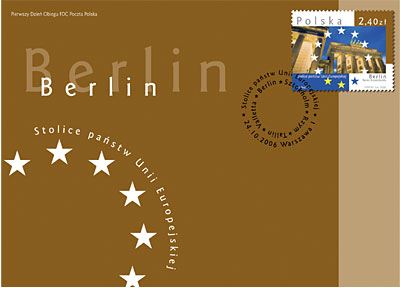 |
|
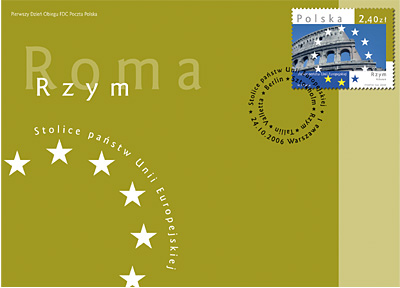 |
|
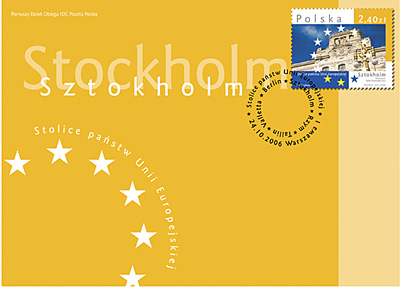 |
|
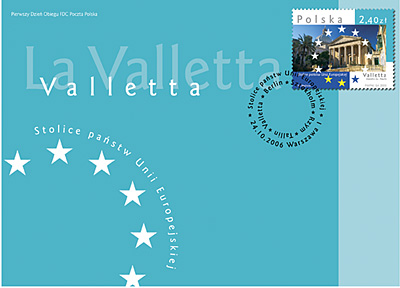 |
|
 |
Dear collectors,
last year there appeared the first part of the set of stamps "Capital
Cities of EU States". At that time Poczta Polska presented characteristic
architectural structures of Budapest, Dublin, Lisbon, Paris and Vilnius. This
time the stamps shall depict German, Italian, Swedish, Estonian, and Maltese
architecture.
The history of European commonwealths dates back to the 50s of the 20th century
that witnessed strict cooperation of a few western European states. The member
states of the European Union, created in 1993, maintain their autonomy, establish
common legal, political, economic and defensive norms. The EU also lays emphasis
on cultural and tourist exchange. Poland has been an EU member since 1st May
2004. The facilitated crossing of borders within the EU inclines the Poles to
travel and get to know the neighbouring countries. By this issue Poczta Polska
encourages to visit the architectural monuments of Berlin (Brandenburg Gate),
Rome (Collosseum), Stokholm (Royal Dramatic Theatre), Tallin (St. Alexander
Newski Cathedral) and Valletta (St. Paul's Cathedral).
The FDC envelopes will be cancelled with a commemorative stamp used in Post
Office Warsaw 1.
World Day of Post

designer: J. Ochendzan
quantity of stamp 1
value: PLN 2.40
issue: 3000000 pcs
printing technique: rotogravure
size of stamp: 31.25 x 43 mm
paper: fluorescent
selling sheet: 50 stamps
circulation date: 9 October 2006
catalogue number: 4120
FDC
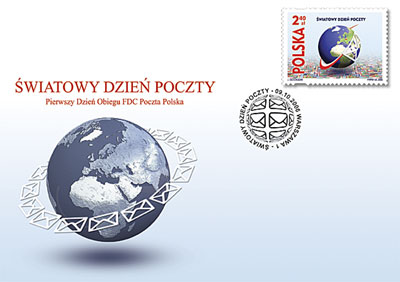
Dear collectors,
Every day millions of messages travel around the world, sent from different
parts of the globe. Postal messages constitute a major part of them. October
9th, celebrated annually as the World Day of the Post, reminds us that the post
is an institution playing significant role in the life of every person, and
of how much there is still to be done as regards access to postal services.
After all there are still many places on the Earth where the nearest post box
is located many kilometers from the place of living. Therefore, the cooperation
of postal institutions around the world and the global standardization of services
are necessary for efficient communication. The Post puts its efforts to gain
customer confidence by its unfailing work, the raising of service quality and
the use of modern technologies.
To celebrate its holiday, Poczta Polska is issuing a stamp illustrating the
global character of postal communication and the significance of international
cooperation of postal institutions.
The FDC envelopes will be cancelled with a commemorative stamp used in Post
Office Warsaw 1.
Polish Alphabet
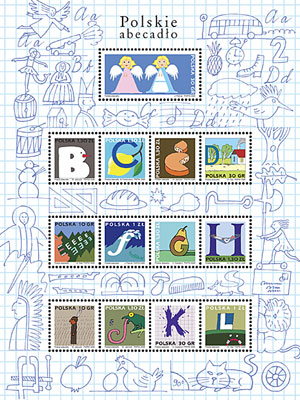
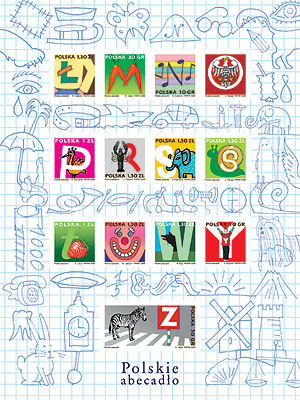
designers: K. Castellini, E. Libera, A. Niemierko, M. Osa,
M. Jedrysik, J. Pietras, K. Syta, W. Terechowicz, J. Wysocki
quantity of stamps: 26
face value: 4 x PLN 0,10 , 6 x PLN 0,30 , 4 x PLN 1 , 12 x
PLN 1.30
issue: 26 x 1000000 pcs
printing technique: offset
size of stamp: letter A and Z - 45 x 22,5 mm, letters from
B to Y - 22,5 x 22,5 mm
sheetlet: 13 stamps
paper: fluorescent
circulation date: 29 September 2006
7
November 2006
catalogue number: 4107-4119
4131-4143
FDC
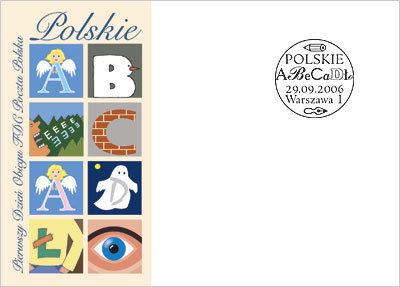
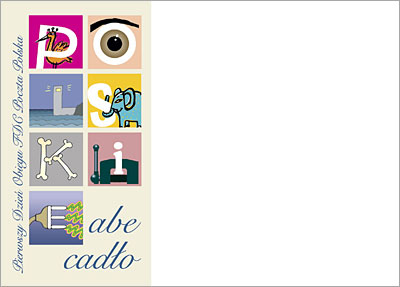
Dear collectors,
"Polish Alphabet" is the name of the set of post stamps whose two issues have been planned by Poczta Polska for fall 2006. The first set will be issued by the end of September, shortly after the beginning of the school year. Therefore, the presented stamp sheets do not accidentally resemble the pages of a pupil's copy-book. Each of them consists of 13 stamps with letters in alphabetical order. The letters have been presented in such a manner so that their learning is a game, as in the first classes of primary school. Children then learn the alphabet by associating letters with the different illustrated words.The deciphering of the drawings around the stamps in sheets may prove an additional amusement. We would be really glad if the set became the first in the collections of young philatelists. Both issues, the September and the November are accompanied by two FDC envelopes cancelled with commemorative stamps used in Post Office Warsaw 1. The second "Polish alphabet" stampsheet will be introduced into postal circulation on 7th november 2006 year.
19th Convention of Polish Philatelic Association
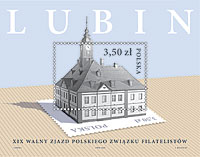
stamp designer:Joanna Gorska
cancel designer:Jacek Brodowski
engraving:Przemyslaw Krajewski
quantity of stamps:1 in form of block
face value: PLN 3.50
issue: perforated block - 300 000 pcs
non-perforated
block - 100 000 pcs
printing technique: rotogravure, steel engraving
size of stamp: 90 x 70 mm
paper: fluorescent
circulation date: 20 September
catalogue number: block 144
FDC
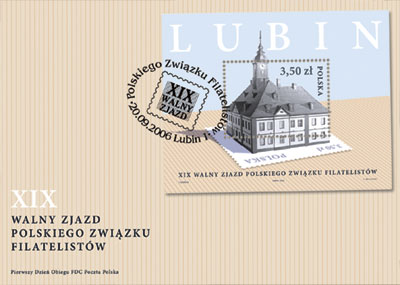
Dear Collectors,
On 23-24 September, there will take place in Lubin the 19th Convention of the Delegates of the Polish Philatelic Association. To commemorate the occasion Poczta Polska has issued a stamp in block. It depicts the Lubin town hall presented in a surrealistic convention, as if standing on a post stamp. In the previous years the conventions took place, among others, in Lodz (1990), Bydgoszcz (1994), Sczecin (1998) and Ciechocinek (2002). In the picturesque Lubin city located in Lower Silesia, known for copper output, there have so far taken place two significant philatelic exhibitions: domestic in 1998 and European ”Euro-Cuprum 2001”. The Polish Philatelic Association cares for the development and high level of philately in Poland and universalizes Polish stamps abroad. It organizes exhibitions and trainings; issues specialized press. It alsoruns the Department of Philately and the Polish Academy of Philately. Mass conventions of PZF take place every 4 years in autumn. Their purpose is the formation of new authorities and the passing of resolutions for the following years. PZF has existed since 1950. On the first day of circulation there will be available an FDC envelope cancelled with a commemorative stamp used in Post Office Lubin 1.
100 Years of Polish Society of Internal Medicine
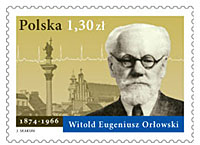
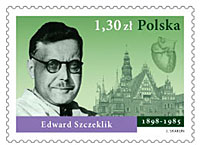
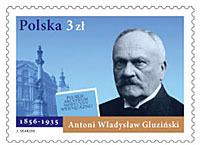
designer:Jerzy Skakun
quantity of stamps: 3
face value: PLN 1.30 , PLN 1.30 , PLN 3
issue: 300 000 pcs
printing technique: offset
size of stamp: 43 x 31.25 mm
paper: fluorescent
selling sheet: 20 stamps
circulation date: 8 September
catalogue number: 4103-4105
FDC

Dear Collectors,
Poczta Polska has issued three stamps presenting three characters: Antoni Wladyslaw Gluzinski, Witold Eugeniusz Orlowski and Edward Szczeklik – doctors rendering meritorious service in the 100-year history of the Polish Society of Internal Medicine. Antoni W. Gluzinski was the chief initiator of the works of the Society and its first president, as well as the founder of the ”Polish Archives of Internal Medicie” magazine issued monthly until today. Generations of internal medicine doctors obtained knowledge from the text-book of Witold E. Orlowski ”Science of Internal Medicine”, subsequent TIP president. Edward Szczeklik, W. E. Orlowski’s student, TIP president in the 1960s, specialized in heart disease diagnosing. He educated many followers as well. Apart from the doctors’ portraits, one can also recognize the cities were they acted, i.e. Lvov, Warsaw and Wroclaw. The year 1906 has been adopted as the date of the founding of the Polish Society of Internal Medicine. Its previous name was ”Society of Internists of the Polish Lands”. The present name, together with the new statute, has been in force since the year 1923. The Polish Society of Internal Medicine is one of the largest medical societies. It organizes numerous conferences and trainings, and cooperates with similar foreign organizations. Other scientific societies developed from its section. The jubilee stamps will be accompanied by an FDC envelope cancelled with a commemorative stamp used in Post Office Warsaw 1.
100th Anniversary of Jerzy Giedroyc's Birth

designer: Jacek Konarzewski
engraving author: Maciej Kopecki
quantity of stamps: 1
price: PLN 1.30
issue: 500 000 pcs
printing technique: steel engraving
size of stamp: 31.25 x 43 mm
paper: fluorescent
selling sheet: 50 pcs
circulation date: 27 July 2006
catalogue number: 4102
FDC
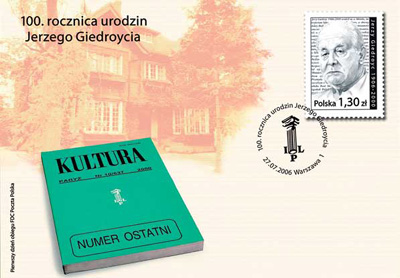
Dear Collectors,
In the year 2006, established by the Seym of the Republic of Poland as the year of Jerzy Giedroyc, Poczta Polska issued a stamp with his portrait to commemorate the 100th anniversary of the birth of the founder and editor of the Paris "Culture". Jerzy Giedroyc was born in Minsk Litewski on 27 July 1906. He studied law and history at Warsaw University. In the 1930s he worked in a few ministries. At the same time he edited magazines, inter alia, the biweekly "Protest of the Young", later transformed into the "Politics" weekly. During World War II, after serving in the Independent Brigade of Carpathian Gunners, he managed the Section of Magazines and Military Publishings in the II Polish Corps. The Literary Institute, founded by Jerzy Giedroyc after the war (1946) became the most important centre of Polish culture on emigration. In Maisons-Laffitte in the vicinity of Paris, for over 50 years, beginning from the year 1947, Giedroyc issued and edited "Culture" (according to the founder's will the magazine ceased to be issued after his death in the year 2000), and from 1962 also "Historical Fascicles". In the "Culture Library" series, since 1953 there appeared the works of authors who could not count on publications in the Polish Peoples' Republic, such as: Marek Hlasko, Slawomir Mrozek, Adam Zagajewski, Stanislaw Baranczak. Among other names linked to the "Culture" are: Gustaw Herling-Grudzinski, Jozef Czapski, Czeslaw Milosz, Konstanty A. Jelenski, Witold Gombrowicz. Far away from his homeland Giedroyc could freely comment on the situation of Poland, although did not write much himself. In the 1970s he backed the opposition but critically evaluated the post 1989 policy. He never succumbed to any ideology, maintaining full freedom and independence which made him prone to the criticism both of emigration circles as well as his countrymen in Poland. He strived for Poland to enter good-neighourliness with the Lithuanians, Ukrainians and the Belorussians. The First Day of Circulation envelope depicts the house in Maisons-Laffitte and the cover of the last issue of the "Culture". The envelope will be cancelled with a commemorative stamp used in Post Office Warsaw 1.
Silver and Golden Objects. Polish - Chinese Joint Issue
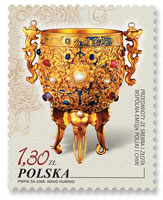
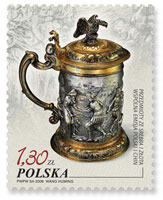
stamp designer - China: Wang Huming
stamp designer - Poland: Marzanna Dabrowska
envelope designer: Marzanna Dabrowska
cancel designer: Agnieszka Sancewicz
quantity of stamps: 2
face value: PLN 1.30
issue: 800 000 pcs
printing technique: rotogravure
size of stamp: 31.25 x 39.5 mm paper: fluorescent
selling sheet: 50 pcs (2 x 25 pcs)
circulation date: 20 June 2006
catalogue number: 4098-4099
FDC
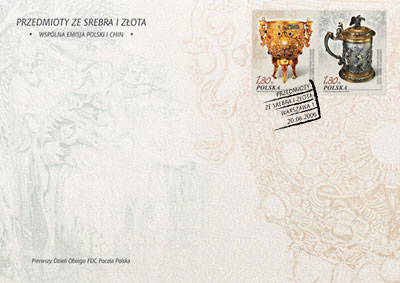
Dear collectors,
The presented post stamps have been produced as a result of the cooperation of Polish Post with China Post. They present museum exhibits of goldsmith mastery: a cup from the Manchurian Qing dynasty of the 18th century and a silver Gdansk mug produced in the period 1660-1680. The Jin Ou Yong Gu cup, made of gold and decorated with pearls, rubies and sapphires can be found in the Emperor's Palace in Beijing. Apart from rich floral ornaments it draws attention by characteristic handgrip handles in the form of dragons and by legs in the form of elephant heads. The cup was used by the emperor during the ceremony of the welcoming of the New Lunar Year. At that time the ruler poured tusu wine into the cup and then calligraphically wrote a text assuring the country prosperity, safety and unity. The cup symbolized the everlasting rule and the permanence of the Qing dynasty. The baroque, partially gilded mug is an example of a vessel of secular character, many of which were ordered at handicraftsmen by rich Polish nobility and middle class. It includes a decoration of moralizing content. The goldsmith Peter Rode (Rohde) depicted on the mug two biblical scenes of the life of Joseph, son of Jacob, with the technique of hand made forged ornaments and scenes. The eagle placed on the top of the lid symbolizes divine might, justice and care spread over people as righteous as the biblical Joseph. The mug comes from the collection of the National Museum in Warsaw. The presented stamps will be issued by both Posts at the same time. On the first day of circulation there will be available FDC envelopes cancelled with a commemorative stamp used in Post Office Warsaw 1.
Year 2006 as Year of Worker's June Revolts


designer: Maciej Jedrysik
quantity of stamps: 2 in form of souvenir sheet
face value: PLN 3.50
issue: 350 000 pcs
printing technique: steel engraving and rotogravure
size of stamp: 43 x 31.25 mm format of souvenir sheet: 90 x 70 mm
papier: fluorescent
daty obiegu: 25 and 28 June 2006
catalogue number: block 142, block 143
FDC
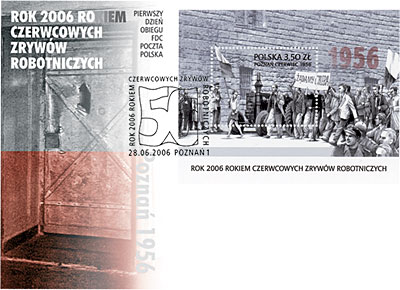
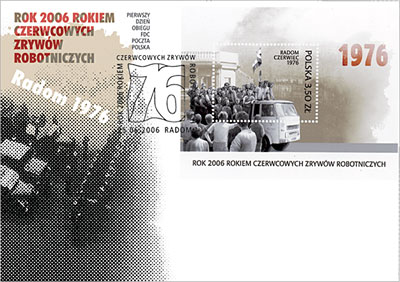
Dear Collectors,
Polish Post, in joining the celebration of the Year of Worker's Revolts, issues two stamps in the form of souvenir sheets commemorating worker's revolts in 1956 in Poznan, and in 1976 in Radom. In the history of post-war Poland, when the country was ruled by the communist PZPR party, for several times there took place mass outbreaks of social dissatisfaction. The then authorities neglectfully treated social problems, the economy gradually declined, and the news presented to the public was false. There was no freedom of speech. The "Poznan June" was the first mass revolt. On 28 June 1956 in Poznan, in the Metal Industry Works, there took place a strike. The laborers demanded a return of the earlier, unjustly lowered wages. On lack of reaction of the authorities, the desperate people, moved by the rumor on the arresting of their delegates, captured the prison building. Fights, with the use of fire-arms and tanks took place at the seat of the Security Office. The pacification lasted until noon of the next day. 75 persons were killed and about 700 injured. Twenty years later, on 25 June, as a result of the announced price increases in food items (at that time prices were fixed by the government), people went out into streets, among others, in Ursus, Plock and Radom, where the largest revolts took place. Strikes and demonstrations were effective - price increases were called off but the persecutions of "hooligans" and "brawlers", as the protesting people were called, lasted until the end of July. The few thousand arrested were beaten, bullied, punished with fines and sacked. The June revolts were unsuccessful but, indirectly, contributed to the growth of awareness in the society and, finally, to the abolishment of communism. On the first day of circulation there will be available FDC envelopes cancelled with commemorative stamps used in Post Office Poznan 1 and Radom 1.
World of Toys
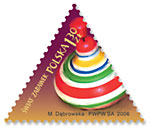
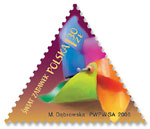
Selling sheets


designer: Marzanna Dabrowska
quantity of stamps: 2
face value: 2 x PLN 1.30
issue: 800 000 pcs
printing technique: offset
size of stamp: 33.04 x 32.34 x 32,34 mm paper: fluorescent
selling sheets: 16 stamps
circulation date: 1 June 2006
catalogue number: 4096-4097
FDC
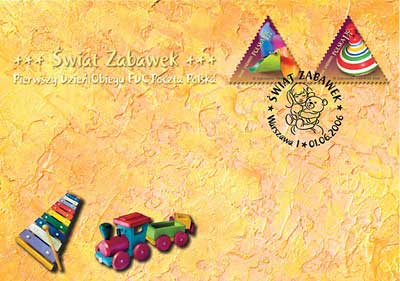
Dear Collectors,
For over 50 years now June 1st is celebrated as Children's Day. On this occasion Polish Post is issuing triangular post stamps with toys. The infrequently used triangular shape is for sure a windfall for philatelists and a challenge for the stamp designer. The two issued post stamps present colorful, whirling objects: a pin-wheel and a peg-top. On the separate stamps solely their fragments are visible. They can be seen as a whole on souvenir sheets including 16 stamps of each type. Even in the age of computer games and electronic gadgets youngsters willingly play with toys as those presented on the stamps. Different examples of toys of this kind, also developing imagination, may be dulcimers and the wooden train presented on the First Day of Circulation Envelope. We hope that this exceptional set shall delight collectors, and remind many Polish Post customers of their childhood. The FDC envelopes will be cancelled with a commemorative stamp used in Post Office Warsaw 1.
Lighthouses
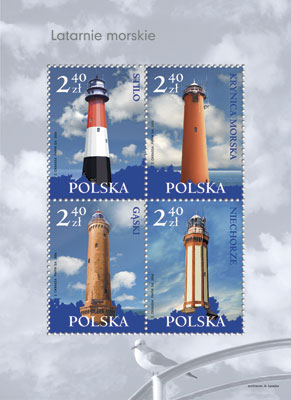
designer: Zygmunt Okrassa
quantity of stamps: 4
face value: PLN 4 x 2.40
issue: 500 000 pcs
printing technique: rotogravure
size of stamp: 31.25 x 43 mm
paper: fluorescent
circulation date 29 May 2006
catalogue number: 4092-4095
FDC


Dear Collectors,
A fire burning on the seaside had for ages helped sailors to safely find their way to the port. The oldest known lighthouse, one of the seven world wonders of the ancient world, was built around 280 BC on the Faros Island. The light range of the old, fire lighthouses was not large up to the 19th century, when gas light, and then electric light, was invented. Today, in the age of the GPS satellite navigation, lighthouses are slowly becoming only a romantic element of the seaside landscape. The lighthouses of the Polish seaside constitute beautiful and interesting examples of ancient architecture and technology. Most are usually architectural monuments open for tourists but still serve seamen. Polish Post presents four of them in its new set of post stamps. The lighthouse in Stilo, with a steel tower (height 33.5 m) on a granite base, was built a hundred years ago. In the 70s of the 20th century the gas light was replaced with electric reflector bulbs on a rotary table. In Krynica Morska, the 19th-century lighthouse was destroyed during World War II. In 1951 a new one was built next to the ruins. The next stamp presents the lighthouse in Gaski. It is almost 50 meters high and has been active since 1878. Humidity and salt have caused a lot of damage, so the antique structure requires particular conservation. On the high cliff coast of Niechorze, there stands an exceptionally beautiful, octagonal, brick lighthouse on a square base. It was first activated in 1866 and later, after the war damages, in 1948. On the first day of circulation there will be available two FDC envelopes cancelled with a commemorative stamp used in Post Office Krynica Morska.
Visit of Pope Benedict XVI to Poland
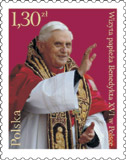
designer: Janusz Wysocki
quantity of stamps: 1
face value: PLN 1.30
issue: 1 000 000 pcs
printing technique: offset
size of stamp: 31.25 x 39.5 mm
paper: fluorescent
selling sheets: 16 stamps
circulation date 25 May 2006
catalogue number: 4091
FDC
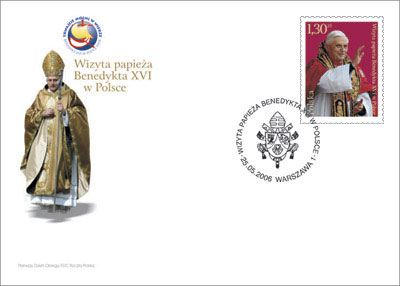
Dear Collectors,
On the occasion of the visit of Pope Benedict XVI to Poland, Polish Post is issuing a commemorative stamp with the image of the Holy Father. During his stay in our country on 25-28 May 2006, the Pope will visit places connected with his predecessor - John Paul II: Wadowice, Krakow, Kalwaria Zebrzydowska and Czestochowa; moreover Oswiecim and Warsaw. "Remain Steady in Faith" is the motto of the first pilgrimage of Pope Benedict XVI abroad. Prior to becoming Pope, Joseph Ratzinger had visited Poland eight times (among others collected two doctorates honoris causa of Polish colleges). He is one of the most eminent contemporary theologians. Joseph Ratzinger lectured on theology in a many universities, among others in Munich, Bonn and Munster. He wrote a few dozen of books and hundreds of articles. He comes from Bavaria, and was born on 16 April 1927 in the town of Marktl. He participated in the II Vatican Council as adviser to Cardinal J. Frings from Cologne. In 1981 John Paul II appointed him the Prefect of the Congregation for the Doctrine of the Faith. Moreover, Joseph Ratzinger worked in several commissions, councils and congregations. He was a close and valued coworker of John Paul II and continues his work, often stressing the merits of his predecessor. "After an outstanding Pope - John Paul II, the cardinals chose me, a simple, modest worker of the Lord's Vineyard" - he said shortly after the announcement of the conclave results on 19 April 2005. On the first day of circulation there will be available an FDC envelope cancelled with a commemorative stamp used in Post Office Warsaw 1.
World Philatelic Exhibition Washington 2006
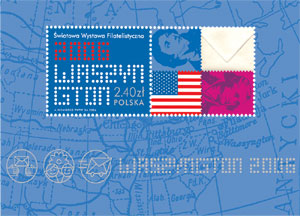
designer: Anna Niemierko
quantity of stamps: 1 with tablet in form of souvenir sheet
face value: PLN 2.40
issue: 500 000 pcs
printing technique: rotogravure
size of stamp: 39.5 x 31.25 mm size of souvenir sheet: 115 x 77 mm
paper: fluorescent
circulation date: 19 May 2006
catalogue number: block 141
FDC
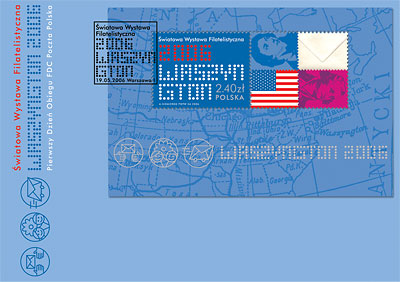
Dear Collectors,
"Stamps and so much more" is the main motto of this year's World Philatelic exhibition organized in Washington under the auspices of the International Philatelic Federation (FIP), in the period 27 May - 3 June 2006. The presented post stamp, issued by Polish Post in the form of a souvenir sheet, relates to the history of the US. On the background of a stylized map of the territory of the former United States presented have been the portraits of Jerzy Waszyngton and Tadeusz Kosciuszko. During the war of 1775-1783 both rendered great service in fighting for the independence of the emerging country. The later, first president of the US, as the commander of the American army, and Kosciuszko, a volunteer from far away Poland, as an excellent commander and military engineer contributed, among others, to the victory of the Americans in the Saratoga battle. The leading topics of the World Philatelic Exhibition, organized in the capital of the US, are: "Role of Post in Uniting a Country", "Children - Our Future" and "The Post Enters the 21st Century". They have been depicted on the stamp and the First Day of Circulation Envelope in the form of pictograms. On the day of the introduction of the stamps into postal circulation, a commemorative stamp will be used in Post Office Warsaw 1.
EUROPA - Integration as Seen by the Young

designer: Anna Niemierko
quantity of stamps: 1
face value: PLN 2.40
issue: 500 000 pcs
printing technique: offset
size of stamp: 31.25 x 43 mm
paper: fluorescent
selling sheet: 20 stamps
circulation date: 5 May 2006
catalogue number: 4089
FDC
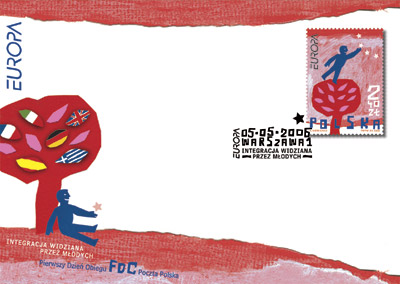
Dear Collectors,
The subject of this year’s issue of post stamps of the „Europa” cycle, published under the auspices of the Association of European Public Post Operators – PostEurop – is integration as seen by young Europeans. The stamp issued by Polish Post presents a person reaching for a „star from the sky”, as for something unattainable. However, as we know, if one dreams of something and wants it very much, everything is possible – if done in cooperation with others. For young people in Poland integration in Europe is above all openness, curiosity and partnership and, at the same time, the awareness of identity with Polish history and culture springing from European roots, but different, commonplace and inalterably valuable. The tree presented on the First Day of Circulation Envelope may symbolize the European „family” to which Poland belongs. Formulated in such a way – integration is something natural and inevitable. It means cooperation beyond boundaries, reaching agreements, at the same time respecting freedom and diversities that contribute to the enrichment and development of each of the members. The FDC envelope will be cancelled with a commemorative stamp used in Post Office Warsaw 1.
Polish cities - Czestochowa
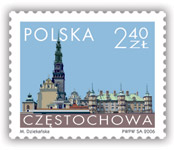
designer: Maria Dziekanska
quantity of stamps: 1
face value: PLN 2.40
issue: many milions repeatable
printing technique: rotograviure
size of stamp: 31.25 x 25.5 mm
paper: fluorescent
selling sheet: 100 stamps
circulation date: 24 April 2006
catalogue number: 4088
FDC
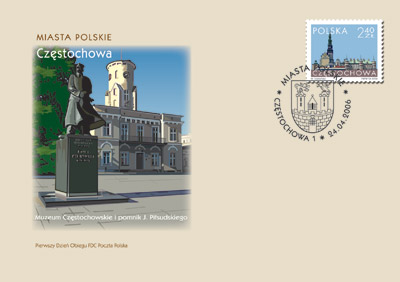
Dear Collectors,
From all the Polish cities Czestochowa most deserves to be called the spiritual capital of Poland. It is picturesquely located among limestone hills, at the Warta River. It has enjoyed city rights since 1377. Already in the year 1382, prince Wladyslaw Opolczyk brought to the city, From Hungary, the Paulinite Fathers to found a convent on Jasna Gora, called so in remembrance of another Jasna Gora – the place of the mother convent of the Paulinite Fathers in Buda. The stamp issued by Polish Post within the „Polish Cities” series presents the convent of Jasna Gora. As the place of pilgrimages, it is each year visited by 3-4 million of visitors. The image of Holy Mary, worshiped until today has been probably present in the convent since the 14th century. During the invasion of the Hussites in 1430, the painting was destroyed (the remaining „scars” on the face of the Mother of God) and required thorough renovation. It is famous for its numerous graces and miracles, evidenced by a multitude of gathered votive offerings. The most important event connected with Jasna Gora was the heroic defense of the convent against the Swedish army during the so called „flood” of 1655. The 17th century witnessed the continuous development of the neighboring city called Czestochowka, and later Nowa Czestochowa. The cities merged in 1826. At present Czestochowa is not only a place of religious cult but also an important industrial, cultural and educational center. The First Day of Circulation Envelope presents a classicist building of the Regional Museum (former city hall) and the monument of Jozef Pilsudski. The FDC envelope will be cancelled with a commemorative stamp used in Post Office Warsaw 1.
Easter

designer: Agnieszka Sancewicz
cancel designer: Marzanna Dabrowska
quantity of stamps: 2
face value: PLN 1.30, PLN 2.40
issue: 22 000 000 pcs, 3 000 000 pcs
printing technique: offset
size of stamp: 43 x 31.25 mm
paper: fluorescent
selling sheet: 100 stamps
circulation date: 3 April 2006
catalogue number: 4086-4087
FDC
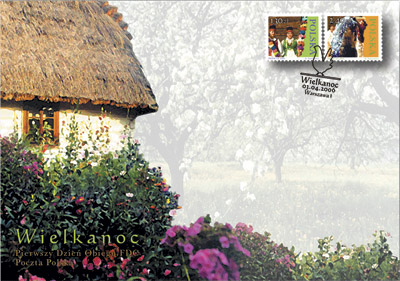
Dear Collectors,
Easter is the oldest and most important Christian holiday commemorating the resurrection of Jesus Christ. Its date is established for the next Sunday after the first springtime full moon, so it falls in March or April. Therefore, the Easter period always occurs in Poland in early spring which additionally accentuates the joyful character of the Holiday of Resurrection. Its symbolism is particularly visible in the cherished folk traditions: the departing winter is associated with overcome death and the spring green with the embryo of new life.
On the occasion of Easter Polish Post has again issued post stamps depicting the traditions of two Easter days: Palm Sunday and Easter Monday, in Poland called smigus-dyngus. The Sunday opening the Holy Week has for ages been called Floral. A procession with "palms", made mainly from willow twigs commemorates Jesus' entering Jerusalem. In some regions of Poland, as Kurpie, the palms are subtly weaved works of art, high and extremely colorful thanks to ribbon and blotting-paper flowers. And smigus-dyngus, i. e. the eagerly cultivated custom of pouring people with water on Easter Monday, may be explained in many ways. At present it is above all a game awaited particularly by children and young people.
On the first day of circulation, the FDC envelope with a spring country landscape will be cancelled with a commemorative stamp used in Post Office Warsaw 1.
Contemporary Polish Sculpture
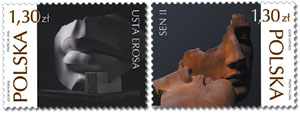
designer: Jerzy Pietras
quantity of stamps: 2
face value: PLN 1.30, PLN 1.30
issue: 500 000 pcs, 100 000 pcs
printing technique: offset
size of stamp: 43 x 31.25 mm
paper: fluorescent
selling sheet: 20 stamps, 2 x 2 sheet
circulation date: 27 March 2006
catalogue number: 4084-4085
FDC
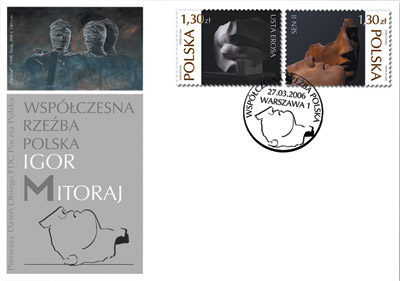
Dear Collectors,
Igor Mitoraj (born in 1944) has for many years lived and created in Italy. He draws inspiration from antique art which, however, he does not copy but transforms and relates to it in his own original way. As the subject of his sculptures he usually selects small fragments of the body, making them assume the features of “destruction”, e.g. cracking. Faces wrapped in cloth or empty forms are frequent motifs. Mitoraj sculpts mainly in marble or bronze and his works are characterized by perfect workshop and performance precision. The artist has for long been valued all world round. His sculptures can be found in many cities and modern art museums in Europe, the US and Japan. His output may be compared to the output of such masters as Alina Szapocznikow or Tadeusz Kantor, under whose supervision Mitoraj studied painting for a short time, but who is a sculptor of easily recognizable, individual style.
Polish Posts presents two stamps within the “Contemporary Polish Sculpture” set depicting the sculptures of Igor Mitoraj: “Dream II” and “Lips of Eros”. It is worth to add that apart from sculpture the artist also deals with draftsmanship. Another example of a different type of his works is the “Sunset” wall painting presented on the First Day of Circulation Envelope. The FDC envelopes will be cancelled with a commemorative stamp used in Post Office Warsaw 1.
Protected and Endangered Species of Polish Flora
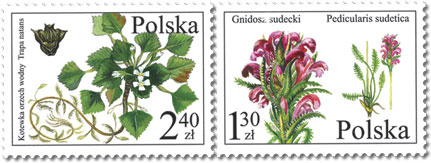
designer: Alojzy Balcerzak, Radoslaw Balcerzak
quantity of stamps: 2
face value: PLN 1.30, PLN 2.40
issue: 800 000 pcs, 600 000 pcs
printing technique: offset
size of stamp: 43 x 31.25 mm
paper: fluorescent
selling sheet: 20 stamps
circulation date: 14 March 2006
catalogue number: 4082-4083
FDC
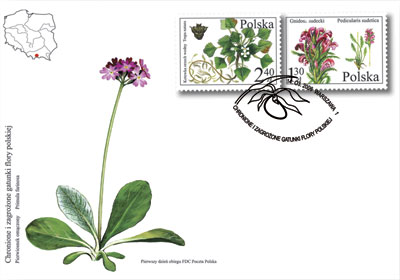
Dear Collectors,
Every day a few dozens of species of flora and fauna disappear from our planet never to return. The ongoing extinction is a natural process. However, in the last decades it has drastically increased due to Man’s destructive activities. The cutting out of forests, regulation of rivers, contamination of environment with industrial waste, use of artificial fertilizers, water and air contamination and the hothouse effect cause serious changes in nature.
Since 1966 the International Union for the Protection of Nature (IUCN) has been publishing a red book of endangered species. The Polish red book of flora noe includes over 1200 of species. In order to remind of the need to care for nature so that it maintains its richness and diversity, on its new stamps Polish Post presents extincting flora species of the southern region of Poland. The Sudety lousewort (Pedicularis sudetica) is a so called post-glacial relict occurring exclusively in the Karkonosze Mountains. The water caltrop (Trapa natans), visible on the second stamp, is an interesting water plant with edible fruits in the form of nuts with four thorns. Additionally, the FDC envelope presents a primrose (Primula farinosa) - the plant of the marshy meadows at the foot of the Tatra Mountains.
The FDC envelope will be cancelled with a commemorative stamp used in Post Office Warsaw 1.
100th Anniversary of Polish Touring Society (PTK)

designer: Jacek Konarzewski
quantity of stamps: 1
face value: PLN 1.30
issue: 1 000 000 pcs
printing technique: offset
size of stamp: 43 x 31.25 mm
paper: fluorescent
selling sheet: 20 stamps
catalogue no.: 4081
circulation date: 20 February 2006
catalogue number: 4081
FDC

Dear Collectors,
In the year 1906, the Poland divided between the three invaders, witnessed the founding of an organization whose aim was to invoke in young people patriotism, strengthen the memory of historical monuments and encourage the cherishing of tradition by showing the beauty of the Polish land. Its founders were: Aleksander Janowski, Karol Hofman, Kazimierz Kulwiec, Kazimierz Czerwinski and Zygmunt Gloger - the first president of the Polish Touring Society. His portrait has been depicted on the stamp that Polish Post issued to commemorate the 100th anniversary of the founding of PTK. Zygmunt Gloger (1845-1910) was a historian, ethnographer and archeologist. He handed down his rich collections, the fruit of 40 years of research work on the culture of old Poland, among others, to the Touring Society. The building visible on the stamp is the former Museum of Industry and Agriculture in Warsaw, where the founding act was signed.
In the inter-war period PTK developed its activity all over Poland (formerly it functioned solely in the Russian sector of partitioned Poland). Numerous branches were formed, hostels and museums were opened, excursions were organized, guides and information leaflets were issued, postcards were printed...
In December 1950, at a special convention, the Polish Touring Society, and a related organization - the Polish Tatra Society - were dissolved. Next the Polish Tourist and Touring Society (PTTK) was founded, which now cares for the development of tourism in Poland by continuing the mission of its predecessors.
The FDC envelope depicts the emblem of PTK. The coats of arms of Cracow, Warsaw and Poznan symbolize the three partitions of Poland. In the middle you can see the ruins of the castle in Ogrodzieniec, as it was there that the idea of the founding of the touring society sprung in 1885. The envelope will be cancelled with a commemorative stamp used in Post Office Warszawa 1.
25th Anniversary of Independent Students' Association (NZS)

designer: Jerzy Pietras
quantity of stamps: 1
face value: PLN 1.30
issue: 300 000 pcs
printing technique: offset
size of stamp: 43 x 31.25 mm
paper: fluorescent
selling sheet: 20 stamps
catalogue no.: 4080
circulation date: 17 February 2006
catalogue number: 4080
FDC

Dear Collectors,
In order to understand why the Independent Students’ Association was formed, one has to imagine the years of communism resembling the reality from Orwell’s books, with press censorship, television censorship, control of all social activities, lack of every kind of freedom, including freedom of speech. For the then authorities the educational system was a very relevant tool in shaping the society. The studying of such subjects as political economy, Marxist philosophy, Russian, and military training were obligatory. Traveling abroad equaled a miracle. However, the isolated society did not lose the will to fight for its rights and for freedom. After the creation of the Independent Self-Governed Union Solidarity in 1980, hope arose for a similar students’ organization.
Already in January 1981 a strike of students of the Lodz University began. The postulates mainly related to the registration of the Independent Students’ Association and the autonomy of universities and colleges in didactical and organizational matters, but also general social changes. Talks with the governmental delegation lasted until 17th February 1981, when NZS was legalized, and on the following day the so-called Lodz Agreement was signed. Martial Law, introduced in December 1981 destroyed the regained freedom but the Polish Peoples’ Republic already neared the end. In 1989 NZS was registered again.
In joining the celebration of the 25th anniversary of the students’ spurt and the founding of NZS, Polish Post issued a stamp to commemorate the events. The graphic on the post stamp and on the FDC envelope relates in style to the underground publications of the period of strife against communism.
On the first day of issue commemorative cancellations will be used in Post Office Lodz 1.
250th Anniversary of the Birth of Wolfgang Amadeus Mozart

designer: Maciej Jedrysik
quantity of stamps: 1
face value: PLN 2.40
issue: 400 000 pcs
printing technique: offset
size of stamp: 43 x 31.25 mm
paper: fluorescent
selling sheet: 20 stamps
catalogue no.: 4079
data obiegu:15 February 2006
catalogue number: 4079
FDC
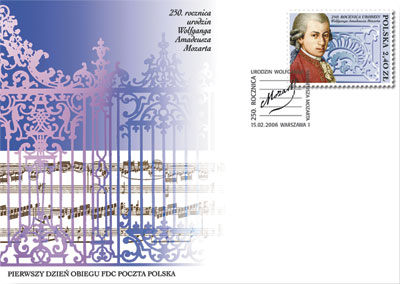
Dear Collectors,
This year shall witness the 250th anniversary of the birth of one of the greatest music geniuses, Wolfgang Amadeus Mozart. On this occasion Polish Post is issuing a commemorative stamp with the image of the composer, patterned from his portrait by Barbara Krafft.
Mozart was born on 27 January 1756 in Salzburg. His father, Leopold, was a well-known musician and the first teacher of his gifted children: son Wolfgang and his 4 years elder sister Nannerl. For the first time the prodigious boy performed for the audience already at the age of five! It was then that he started writing his first compositions. From 1762 the Mozart family traveled around Europe giving very successful concerts at courts. During those travels Wolfgang learned much, among others, from the son of J.S. Bach, Johann Christian. In his family town, Salzburg, Mozart worked many years at the court of the prince archbishop as a concertmaster but the employer’s requirements hindered the development of his talent. In 1782 he married and settled in Vienna. Six years later he received the title of the emperor’s composer. He was a member of one of the Vienna Freemasons’ Lodges.
Mozart lived short (died on 5 December 1791), but created easily, so he left a vast musical output. He composed operas (“Figaro’s Wedding”, “The Magic Flute”, “Don Giovanni”), concerts, symphonies, masses, string quartets, piano sonatas, serenadas (e.g. the famous “Eine kleine Nachtmusik”), songs and canons. His last, unfinished composition was the wonderful “Requiem”. Despite his genius he was not always duly appreciated and had financial problems. After death he was buried in a mass grave, perhaps due to the plague.
The FDC envelope accompanying the stamp has been decorated with an ornament characteristic for the composer’s époque, combined with a note inscription. It will be cancelled with a commemorative stamp used in Post Office Warsaw 1.
I Love You

designer: Andrzej Gosik
quantity of stamps: 1+ 1 with empty field
face value: PLN 1.30
issue: 3 900 000 pcs, 800 000 pcs
printing technique: rotograviure
size of stamp: 31.25 x 43 mm
paper: fluorescent
selling sheet: 50 stamps, 8 + 8 empty field
catalogue no.: 4078
circulation date: 10 February 2006
catalogue number: 4078
FDC
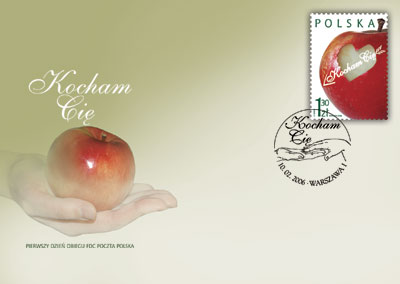
Dear Collectors,
St. Valentine’s Day is a relatively young holiday in Poland. It has only been celebrated for about 15 years. Despite the fact, each year it is gaining an increasing number of advocates. The 14th of February is a pleasant beguile of time while waiting for warmer days, the first rays of the spring sun. It is also a colourful accent in the still winter month.
St. Valentine’s is unchangingly popular in the Anglo-Saxon countries. It is the next day after Christmas before which greeting cards are so numerously sent, not only to those beloved, but to all persons close to the heart: friends, parents, children, neighbours, teachers, etc. It is simply a wonderful occasion to express the feelings of liking.
And once again Polish Post is presenting a stamp dedicated to St. Valentine’s Day. A red apple with a cut out heart and an “I Love You” inscription in the shape of a Cupid’s arrow will be a nice supplement to a Valentine letter or card. We also encourage to take advantage of our exceptional offer - the Valentine stamp will be issued in two forms: as a separate stamp and as a personalized stamp with empty field for placing a photo of the beloved person, a family holiday photo, one’s own image or a chosen picture. The fantasy of those in love is endless, this is why we encourage both those seeking their “second half of the apple” as well as those who have already found it to express their feelings in such an unconventional manner.
The “I Love You” stamp is accompanied by an FDC envelope, which will be cancelled with a commemorative stamp used in Post Office Warsaw 1.
20th Winter Olympic Games TURIN 2006

designer: Jacek Brodowski
quantity of stamps: 1 with tablet
face value: PLN 2.40
issue: 500 000 pcs
printing technique: offset
size of stamp: 43 x 31.25 mm
paper: fluorescent
selling sheet: 10 stamps + 10 tablets
catalogue no.: 4077
circulation date:7 February 2006
catalogue number: 4077
FDC
Dear Collectors,
10-26 February is the period of the winter olympic games in Turin. On this occasion, particularly due to the numerous participation of Poles in the games, Polish Post has prepared a special stamp. The dynamic, graphically modern post stamp presents a colourful group of sportsmen, and on the tablet included has been the text of the Olympic oath of Polish sportsmen. The picturesque panorama of the mountains and a fragment of the view on Turin constitute the background for both parts.
The first winter olympic games were held in 1924 and are organized every four years. Italy is for the second time hosting the games (in 1956 the winter games took place in Cortina d’Ampezzo in the Dolomites). Turin is the capital of Piemont, a city of multi-age, rich history, located at the foot of the Alps. It is mostly famous for the place of the storage of the Turin Shroud and the seat of the FIAT automotive company, as well as the famous football team Juventus.
At the Turin Olympic Games our representation will be competing in the following sports disciplines: biathlon, bobsleighs, figure skating and fast skating, Alpine and race skiing, sledging, skeleton, short-track, ski-jumping and snowboard.
The First Day of Circulation Envelope will be cancelled with a commemorative stamp used in Post Office Warsaw 1.

 Enlarge
Enlarge